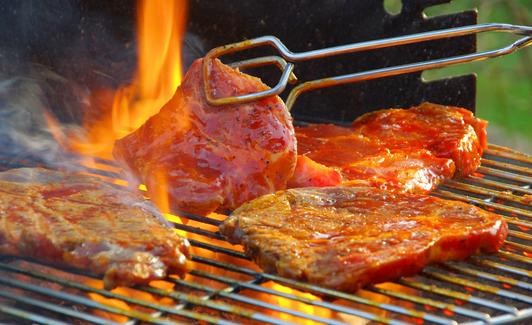Grilling is an art, no doubt. I make an effort to grill whenever I get the chance: steaks, pork chops, sausages, vegetables and just about everything in between. I recently came across this article with some great grilling tips for enthusiasts like myself:
1. The debate over gas vs. charcoal is an old one indeed. No studies have yet to prove which method is healthier, but gas does burn cleaner. Charcoal grills tend to emit more carbon monoxide, and let loose matter and soot into the atmosphere, contributing to increased pollution. However, many people prefer the smokier, richer taste of food cooked on a charcoal grill.
2. To make sure that your grill reaches the right temperature, make sure that you preheat it 15 to 25 minutes before you start to cook. Your grill should be 400-450 F for high, 350-400 for medium-high, 300-350 for medium and 250-300 for low. A properly heated grill sears foods on contact, keeps the insides moist and helps prevent the age-old problem of sticking. Searing might not “seal in” the juices, but it does create improved flavors through caramelization.
3. If you choose to grill with charcoal, then it’s a good idea to stick with additive-free lump charcoal. Conventional briquettes may contain wood scraps and sawdust as well as coal dust, sodium nitrate, borax and additives like paraffin or lighter fluid. You should avoid lighter fluid altogether, since it can release volatile organic compounds into the air, leave unpleasant residue where you don’t want it and pose a serious danger if used improperly.
4. It’s a lot easier to remove debris when your grill is hot, so after preheating, use a wire grill brush to clean off charred debris from earlier meals.
5. Even on the cleanest grill, lean foods could stick when you place them directly on the rack. To reduce sticking, oil your hot grill rack with a vegetable oil-soaked paper towel. Hold it with tongs and rub it over the rack. DO NOT use cooking spray on a hot grill.
6. Safety is always essential, so keep these simple USDA rules in mind: avoid cross-contamination by using separate cutting boards, utensils and platters for raw and cooked foods; refrigerate foods while marinating and never baste with the marinating liquid. Make extra marinade just for basting, or boil your marinating liquid first.
7. Marinating doesn’t just infuse food with flavor, it also inhibits the formation of potentially carcinogenic HCAs which form when grilling meats such as fish, poultry and red meat.
8. A chimney starter makes starting a charcoal fire a whole lot easier. All you have to do is put some crumpled paper in the bottom of the chimney, fill it with charcoal and light the paper. In about 20 minutes, the coals will be ready to spread evenly in the bottom of the grill.
9. The best way to know if protein is fully cooked is to check its internal temperature with an instant-read thermometer.
10. Use a grill basket for foods that might fall through the grill rack or are too cumbersome to turn over one by one, such as vegetables, tofu, fruits and fish.
11. To gauge the temperature of a grill without a thermometer, place your palm about 5 inches above the grill rick; the fire is high if you have to move your hand in 2 seconds, medium if you have to move your hand in 5 seconds and low if you have to move your hand in after 10 seconds.
12. Flare-ups happen when fat drips onto the heat source and catches fire, which causes carcinogenic PAHs to form and accumulate on your food. Meat licked by flames also tastes off, and flames could char the outside of food before the inside has been thoroughly cooked. To reduce flare-ups, select lean cuts of meat, trim excess fat and remove poultry skin.
13. Once you’ve finished grilling, let the finished product rest on a clean platter, tented with foil, for about 10 minutes before carving so that juices can redistribute evenly.
